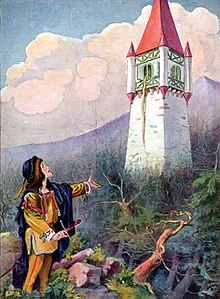 "Rapunzel" is a German fairy tale in the collection assembled by the Brothers Grimm, and first published in 1812 as part of Children's and Household Tales.[1] The Grimm Brothers' story is an adaptation of the fairy tale Persinette by Charlotte-Rose de Caumont de La Forceoriginally published in 1698.[2] Its plot has been used and parodied in various media and its best known line ("Rapunzel, Rapunzel, let down your hair") is an idiom of popular culture
"Rapunzel" is a German fairy tale in the collection assembled by the Brothers Grimm, and first published in 1812 as part of Children's and Household Tales.[1] The Grimm Brothers' story is an adaptation of the fairy tale Persinette by Charlotte-Rose de Caumont de La Forceoriginally published in 1698.[2] Its plot has been used and parodied in various media and its best known line ("Rapunzel, Rapunzel, let down your hair") is an idiom of popular culture
A childless couple that wanted a child lived next to a walled garden which belonged to an enchantress. The wife, as a result of her long-awaited pregnancy, noticed a rapunzel plant (or, in some versions[5] of the story, rampion radishes or lamb's lettuce) planted in the garden and longed for it to the point of death. For two nights, the husband went out and broke into the garden to gather some for her; on the third night, as he was scaling the wall to return home, the enchantress, whose name is said to be "Dame Gothel", caught him and accused him oftheft. He begged for mercy, and the old woman agreed to be lenient, on condition that the then-unborn child be surrendered to her at birth. Desperate, the man agreed. When the girl was born, the enchantress took her and raised her as a ward, naming her Rapunzel. When Rapunzel reached her twelfth year, the enchantress shut her away into a tower in the middle of the woods, with neither stairs nor door, and only one room and one window. When the witch went to visit Rapunzel, she stood beneath the tower and called out:
- Rapunzel, Rapunzel, let down your hair, so that I may climb the golden stair.
Upon hearing these words, Rapunzel would wrap her long, fair hair around a hook that sat beside the window and drop it down to the enchantress, who would then climb up the hair to Rapunzel's tower room. A variation on the story also has the enchantress imbued with the power of flight and/or levitation and the young girl unaware of her hair's length.
One day, a prince rode through the forest and heard Rapunzel singing from the tower. Entranced by her ethereal voice, he went to look for the girl and found the tower, but was unable to enter. He then returned often, listening to her beautiful singing, and one day saw Dame Gothel visit, thus learning how to gain access to Rapunzel. When Dame Gothel was gone, he bade Rapunzel let her hair down. When she did this, he climbed up, made her acquaintance, and finally asked her to marry him. Rapunzel agreed.
Together they planned a means of escape, wherein he would come each night (thus avoiding the enchantress who visited her by day), and bring her silk, which Rapunzel would gradually weave into a ladder. Before the plan came to fruition, however, Rapunzel foolishly gave the prince away. In the first edition of Grimm's Fairy Tales, Rapunzel innocently says that her dress is getting tight around her belly; in subsequent editions, she asks the witch (in a moment of forgetfulness) why it was easier for her to draw him up than her.[6] In anger, Dame Gothel cut short Rapunzel's braided hair and cast her out into the wilderness to fend for herself. When the prince called that night, the enchantress let the severed braids down to haul him up. To his horror, he found himself staring at the witch instead of Rapunzel, who was nowhere to be found. When she told him in anger that he would never see Rapunzel again, he leapt from the tower in despair and was blinded by the thorns below. In another version, the witch pushes him and he falls on the thorns, thus becoming blind.
For months he wandered through the wastelands of the country. One day, while Rapunzel sang as she fetched water, the prince heard Rapunzel's voice again, and they were reunited. When they fell into each others' arms, her tears immediately restored his sight. In another variation, it is said that Rapunzel eventually gave birth to two boys (in some variations, a girl and a boy). The prince leads her to his kingdom, where they lived happily ever after. In another version of the story, the ending reveals that the witch untied Rapunzel's braid after the prince leapt from the tower, but it slipped from her hands and landed below the tower. This left the witch trapped in the tower.
The original story came from the story of Rudaba in an ancient Iranian book called Shahnameh, written by Ferdowsi around 1000 AD.[7] Some elements of the fairy tale might also have originally been based upon the legends about Saint Barbara, who was said to have been locked in a tower by her father.[8]





0 comments:
Post a Comment